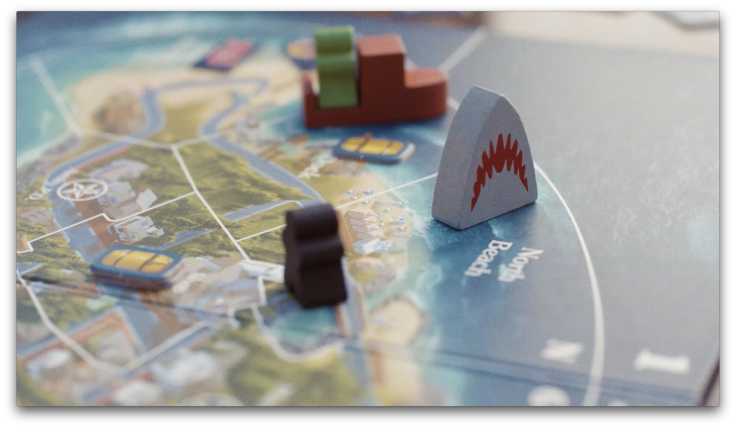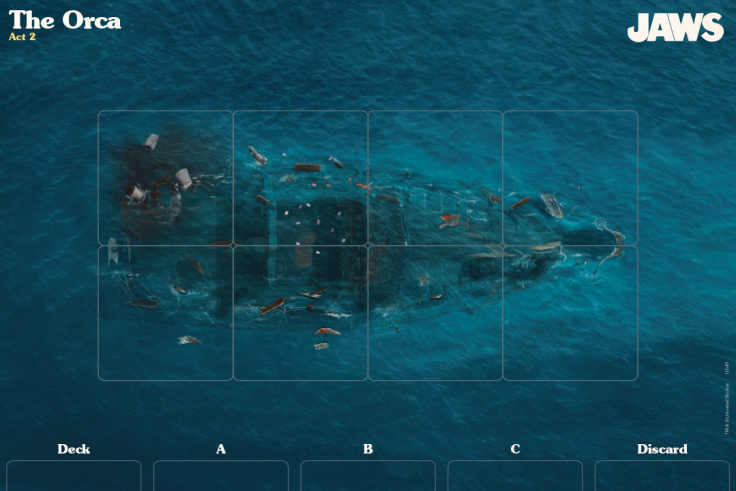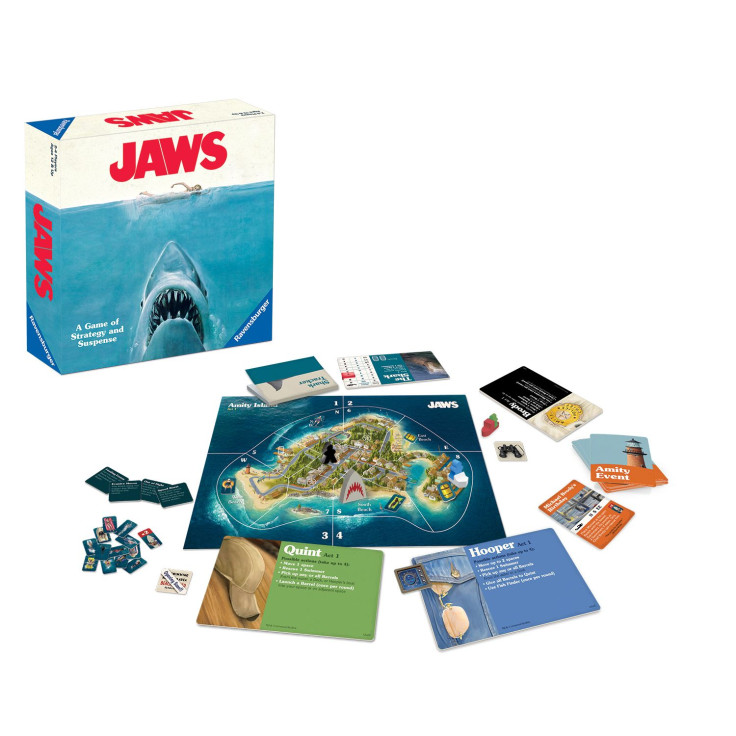The 1975 smash-hit movie Jaws broke box office records for giving players a fear of what lurked beneath the surface. While the Jaws board game can’t quite recreate that same sense of fear, it does a pretty good job of emulating feelings of urgency and hopelessness against an unseen foe.
There are so many smart ideas going on in a game of Jaws . The most noticeable out of the box is the division of the game into two Acts, each with their own rules, board, and pieces. Act One is set on Amity Island, while Act Two takes the players out into the middle of the ocean on the tiny ship The Orca. It can be a bit awkward switching between the two, but each Act’s distinct rules and tone feel like you get to play two games in one sitting, which is pretty neat.

Jaws divides players up into two teams. One player takes on the role of the shark, while the remaining players control the human characters. In Act One, it’s the shark’s job to eat as many swimmers as possible, while the humans must do everything they can to prevent the loss of life and hit the shark with tracking barrels.
One really smart idea during Act One is the ability for the shark player to keep his or her actions secret from the other team. Thanks to the added “Shark Tracker” paper pad, the shark player records all moves made for each round so there is a record of where the shark is at all times. This helps keep things both hidden and fair for both sides.
This half of the game seemed to really emphasize the hopelessness and fear of being a human during a shark attack. While playing, no team of humans even managed to hit the shark player once with a single tracking barrel, let alone the two needed to finish the round. Instead, the shark player always seemed to easily chomp up the required nine swimmers to advance the game to Act Two. Despite the human players having more moves to use during each round, the humans always felt like they were a step behind the shark player and could never keep up. This raised a few questions with my group about game balance that will be brought up later in the review.

Who wins Act One, and by how much, does come into play for Act Two. If the shark player does better, he or she gets more Shark Action cards during the final showdown. Similarly, if the humans can manage to pin down the shark, that team gets additional resources to help fight off the shark on The Orca.
Act Two plays out like a survival game instead of a hunt, as the shark player chips away at the boat while the humans do everything they can to kill the unstoppable beast. The boat itself is made up of a series of tiles that get flipped over once that area of the boat is damaged. If an area becomes completely destroyed, the tile is removed from the board. The game ends when the shark player either completely destroys The Orca, kills all the humans, or the humans rally and finally kill the great white monster.
As mentioned earlier, in our games with Jaws, the shark player was never stopped in Act One, meaning the shark player had the advantage going into Act Two. Despite the strong advantage, Act Two was remarkably balanced. Our games were always tightly contested, with one game even culminating in one final roll of the dice to determine if the humans lived or the boat was destroyed.

This raises the question about overall game balance. Is Act One supposed to be wildly unbalanced in the favor of the shark player? If so, it does make for a balanced Act Two. While we never had this happen to us, it seems like the more resources the humans would have, the easier it would be to kill off the shark in Act Two. An unbalanced Act One also thematically makes sense, as the shark in the Jaws movie was shown to be this unstoppable threat.
However, both Act One and Act Two can be played as stand-alone games. The modified rules for playing the two acts by themselves seems like it immediately favors one team over the other. If you play Act One by itself, the shark player wins if seven swimmers are eaten instead of nine, which seems ridiculously easy. Act Two as a stand-alone game gives the humans six resource cards instead of the three we used each game, which means they should have a pretty strong chance compared to playing both Acts together.
Despite these odd balance questions, the games of Jaws we played ended up tightly contested and, more importantly, were really fun. The components are well-made and the dual-sided board layout is a really clever design. Perhaps most importantly for fans of the movie, Jaws captures that feeling of facing off against a hidden, unrelenting foe and managing to barely escape death (or succumbing to your watery grave). If you are a fan of the movie, or are looking for a unique two-games-in-one board game, Jaws is sure to be a hit at your next game night.
Jaws is available right now at Target.


















